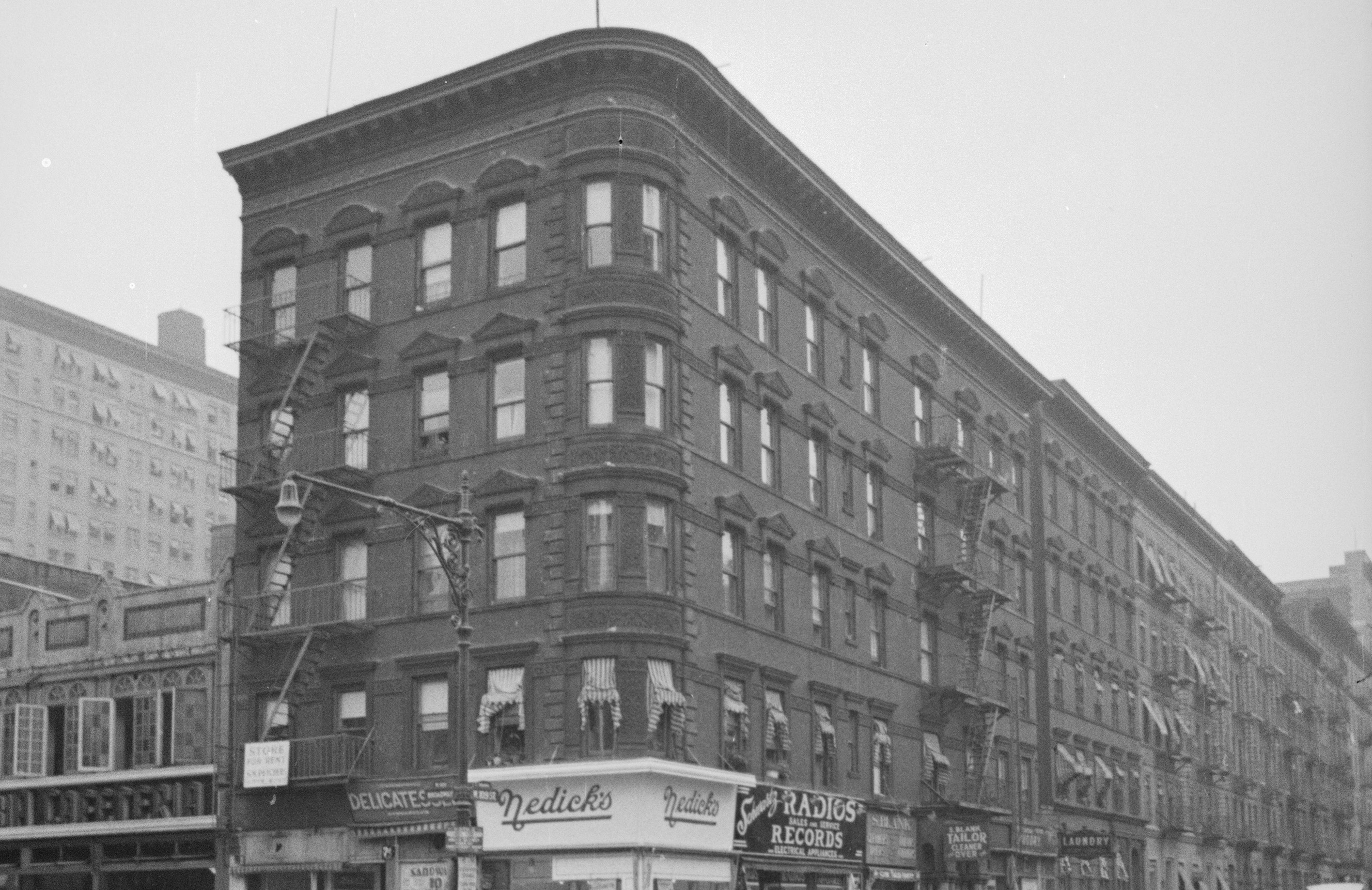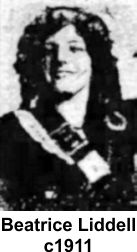
2820 Broadway
by Tom Miller
In October 1897, the Record & Guide reported that John Hickey had purchased the vacant lots at the “Boulevard, northeast corner of 109th street.” His plans for the parcel were not entirely developed yet. The article said he would build a “five or six-story apartment house.” It would be nearly three months before his mind was made up. On January 14, 1898, the architectural firm of Neville & Bagge filed plans for two five-story “brick and stone flats.”
Completed the following year, the corner building was an architectural fraternal twin of the smaller building at 253 West 109th Street. It had a commercial space on the ground floor, and its residential entrance was around the corner at 259 West 109th Street. Designed in a blend of Renaissance Revival and Romanesque Revival styles, its windows wore Renaissance-inspired pediments, and ornately carved stone panels decorated the rounded corner bay.
The five-room-and-bathroom suites rented for $28 per month in 1902—around $900 today. The ground floor was home to William Dryer’s café, which would remain until around 1915.
Among the residents in 1904 was Blanche McMallan, a manicurist. Blanche was addicted to liquor and her drinking became so serious a problem that she was committed to the alcoholic ward at Bellevue Hospital. When alcohol withdrawal set in, Blanche became violent. On March 10, 1904, The Sun said, “The woman made so much trouble on Tuesday night that she was put into a separate room.” Tragically, Blanche could not endure the torture. A nurse left her room around noon on March 9. “When she returned,” said The Sun, “she was unable to open the door. Peering through the wire meshing at the top she saw the woman’s body hanging from the transom.”
When alcohol withdrawal set in, Blanche became violent.
One resident created an unintentional commotion in Times Square on September 20, 1906. As Mrs. T. J. McGrane and her mother stepped off a Broadway streetcar in front of the Times Building, the gold chain that fastened her locket to her dress caught on the back of a seat and broke. The New York Times reported, “the locket went through the air and down into the sidewalk ventilator leading from the Subway in front of the Times Building. Within ten seconds fifty men were peering down into the muddy water at the bottom of the ventilator, and fifty more were trying to do likewise.”
While one man after another tried to fish out the locked, using canes, a hook attached to a wire, and other items, Mrs. McGrane stood dejectedly by, “the recipient of pity and commiseration from the feminine division of the crowd.” In the meantime, her would-be heroes pulled out cigar butts, a banana skin, and bits of paper.
Hearing the commotion, Thomas Brackenson, a porter in the building, investigated. He then quietly slipped down to the subway platform, climbed up to the ventilator, reached in, and retrieved the locket. Mrs. McGrane called his solution “both bright and simple” and handed him several bills as thanks.
Violinist Gregor A. Gaitz-Hocky and his wife lived here in 1911. Born in Russia, he was the nephew of Prince Alexis Baronova and in his homeland would have been known as Baron Gaitz-Hocky. His musical mastery won him a valuable violin at the Berlin Conservatory at the age of 18. Without informing his family, he traveled to America, beginning his career in New Orleans as the leader of a French opera orchestra. In 1909, “he created a small stir,” said The New York Times, while conducting the orchestra at the Knickerbocker Hotel. He was recognized by his uncle, Prince Baronova, who happened to be staying there. The newspaper said, “His uncle wanted him to return to Russia, it was said, promising him an inheritance if he entered the Imperial Army, but the violinist refused.” (It was a prodigious decision since the Bolshevik Revolution was just six years away.)
In 1911, Gaitz-Hocky had been the leader of the Plaza Hotel orchestra for three years. He was a favorite among the wealthy women, one of whom was said to take him on automobile rides through Central Park. The New York Times claimed the women “have come to thoroughly fall in love with Gaitz-Hocky’s art.” So much in love with his art were they, that six of them surprised him on his 30th birthday with a party at the Plaza Hotel, and the gift of a $12,000 Stradivarius violin, crafted in 1715. (The woman who drove around Central Park with the violinist had donated $5,000 toward the instrument—nearly $150,000 by today’s standards). A reporter who visited the Gaitz-Hocky apartment was unable to prompt him to divulge his benefactors’ names. “People might talk in New York if they knew,” he said. “Those woman, particularly that one woman, have been so kind to me that I must respect their wishes now.”
Detectives Donnelly, Quinn and Byrnes were at the corner of Columbus Avenue and 104th Street on the afternoon of March 20, 1913, when they noticed two boys “displaying jewelry and flashing rolls of bills such as small boys are not in the habit of carrying,” according to The Evening Post. Donnelly walked up and said, “You look like a couple of rich kids—with those rings on.”
“We sure are,” one of them replied. “We’re wealthy guys. We’ve got rings on our fingers, and—see this!” He held up rolls of bills—both hundreds and twenties. The Evening Post reported, “The boys were marched to the station.”
Eighteen-year-old William Stein and 17-year-old Joseph Scott were messenger boys. Stein carried a chamois jewel case with the initial “B” containing six diamond rings and $400 in cash—a total value estimated at $141,000 in today’s money.
He held up rolls of bills–both hundres and twenties. The Evening Post reported, “The boys were marched to the station.”
In the meantime, the Handt apartment at 259 West 109th Street had been in turmoil for days. Mrs. Margaret Beatrice Liddell was headed for England and while in New York she was a houseguest of the Handts. Her jewelry case had suddenly gone missing, and she finally was forced to depart on the White Star liner Baltic on March 19 without them.
Now, back at the station house, the boys explained that another messenger, James Reilly had met them the previous day and had “a big box full of jewelry and money. Stein and Scott got a share, they said.” Reilly was the next to be arrested and questioned. He admitted to taking the box while collecting laundry at the West 109th Street building. But there, police were unable to find anyone with a name beginning with “B.” It was 24 hours before Mrs. Liddell’s loss was connected to the robbery.
In 1915 Kahn & Co., a “ladies’ furnishings” store, took over the former café space. It was still there four years later when an advertisement read, “Salesladies wanted in blouse shop. Must be experienced. Good salary and steady position. 2820 Broadway, corner 109th St.”
The residents of the building were still financially comfortable and respectable. Among them in 1920 was the unmarried Arda Bates Rorison, whose distinguished American pedigree entitled her to memberships in the Daughters of the American Revolution, the Dames of the Revolution, and the National Patriotic Women of America, among other colonial societies.
At some point, a clumsy attempt to modernize the appearance of the building resulted in the pediments being covered in a bland, concrete-like substance. The entrance portico received the same treatment. A modern storefront leaves no hint of the original. And yet, with a little imagination we can envision the building as it was when Broadway was still known as the Boulevard.
Tom Miller is a social historian and blogger at daytoninmanhattan.blogspot.com
Building Database
Keep Exploring
Be a part of history!
Think Local First to support the local businesses at 2820 Broadway aka 259 West 109th Street:



